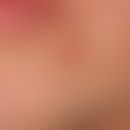Synonym(s)
HistoryThis section has been translated automatically.
DefinitionThis section has been translated automatically.
You might also be interested in
Occurrence/EpidemiologyThis section has been translated automatically.
EtiopathogenesisThis section has been translated automatically.
ClinicThis section has been translated automatically.
Nails: Anonychia, hyponychia, onychoschisis, triangular lunula. Affected are mainly thumb and index finger nails; toe nails are almost always normal.
Bones and joints: aplasia or hypoplasia with subluxation of the patella, hypoplasia of the radial head, subluxation of the radius, exostosis-like pelvic horns (Fong's symptom), scapular hypoplasia, scoliosis, genu valgum, pes equinovarus.
Genitourinary system (40ige involvement): renal dysplasias, ureteral duplication, nephrotic syndrome, Goodpasture's syndrome, renal failure, chronic pyelonephritis.
Eyes: Heterochromic iris, glaucoma, microcornea.
HistologyThis section has been translated automatically.
Kidney biopsy: Thickening of the glomerular basement membrane by collagen fibrils.
TherapyThis section has been translated automatically.
Progression/forecastThis section has been translated automatically.
LiteratureThis section has been translated automatically.
- Beguiristain JL et al (2003) Nail-patella syndrome: long term evolution. J Pediatric orthopaedic surgeon B 12: 13-16
- Bongers EM et al (2002) Nail-patella syndrome. Overview on clinical and molecular findings. Pediatric Nephrol 17: 703-712
- Burkhart CG et al (1980) Nail-patella syndrome. J Am Acad Dermatol 3: 251-256
- Little EM (1897) Congenital absence or delayed development of patella.
- Lancet (London) 2: 781-784
- Nowak C (1979) Turner-Kieser syndrome. Dermatologica 3: 576-577
- Ogden JA et al (2002) Nail patella syndrome. A 55-year follow-up of the original description. J Pediatric orthopaedic surgeon B 11: 333-338
- Austrian W (1929) Nail and skeleton anomalies. Viennese clin weekly 43: 632
- Protas-Dozd F et al (1979) Nail-Patella Syndrome. Dermatologica 3: 575-576
- Schulz-Butulis BA et al (2003) Nail-patella syndrome. J Am Acad Dermatol 49: 1086-1087
- Trauner R, Rieger H (1925) A family with 6 cases of dislocation radii congenita with consistent anomalies of the finger and knee joints and nail formation in 4 generations. Arch klin Chir (Berlin) 137: 659-666
Incoming links (16)
Anonychia-electrodactyly syndrome; Arthroosteoonychodysplasia; Austrian syndrome; Eye diseases, skin changes; Nail-patella-elbow syndrome; Nail-patella syndrome; Onychardrosis hereditaire; Onychodysplasia congenital of the index finger; Onychodystrophy (overview); Osteo-arthro-onycho-dysplasia; ... Show allOutgoing links (1)
Onychoschisis;Disclaimer
Please ask your physician for a reliable diagnosis. This website is only meant as a reference.




